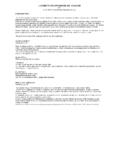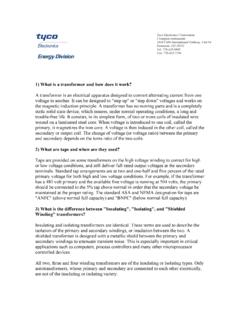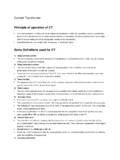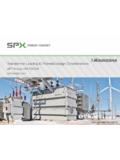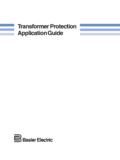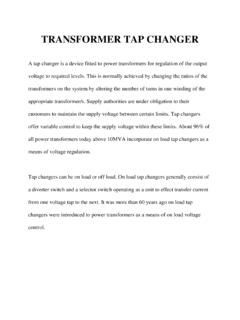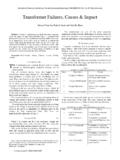Transcription of A GUIDE TO TRANSFORMER OIL ANALYSIS BY I.A.R. GRAY ...
1 A GUIDE TO TRANSFORMER OIL ANALYSIS BY GRAY TRANSFORMER Chemistry Services INTRODUCTION The fault free operation of power transformers is a factor of major economic importance and safety in power supply utilities and industrial consumers of electricity. In the current economic climate, Industries/Supply Utilites tighten their control on capital spending and make cutbacks in maintenance, an increased awareness is placed on the reliability of the existing electric power supply. Down time is at a premium. Often, the loading is increase on present units , as this will defer purchasing additional plant capacity. Thus the stress on the TRANSFORMER increases. The net total effect of the thermal , electrical and mechanical stress brought on by increased service needs to be monitored to ensure reliability.
2 Regular sampling and testing of insulation oil taken from transformers is a valuable technique in a preventative maintenance program. If a proactive approach is adopted based on the condition of the TRANSFORMER oil, the life of the TRANSFORMER can be extended. This paper reviews some of the TRANSFORMER oil tests and there significance. WATER CONTENT Test Method IEC 814 Water, in minute quantities, is harmful in power equipment because it is attracted to the places of greatest electrical stress and this is where it is the most dangerous. Water accelerates the deterioration of both the insulating oil and the paper insulation, liberating more water in the process (heat catalysed).
3 This is a never ending circle and once the paper insulation has been degraded(loss of mechanical strength) it can never (unlike the oil) be returned to its original condition. Origins of Water Water can originate from two sources. Atmospheric Via the silica gel breather (dry silica gel is always blue). Via leaks into the power equipment, bad gasketing, cracked insulation, a loose manhole cover, a ruptured explosion diaphragm etc. (if oil can get out, water can get in). Internal Sources Paper degradation produces water. Oil degradation produces water. Wet insulation contaminates the oil, (temperature dependent). DIELECTRIC STRENGTH Test Method: IEC 156 The dielectric strength of an insulating oil is a measure of the oils ability to withstand electrical stress without failure.
4 The test involves applying a ac voltage at a controlled rate to two electrodes immersed in the insulating fluid. The gap is a specified distance. When the current arcs across this gap the voltage recorded at that instant is the dielectric strength breakdown strength of the insulating liquid. Contaminants such as water, sediment and conducting particles reduce the dielectric strength of an insulating oil. Combination of these tend to reduce the dielectric strength to a greater degree. Clean dry oil has an inherently high dielectric strength but this does not necessarily indicates the absence of all contaminates, it may merely indicate that the amount of contaminants present between the electrodes is not large enough to affect the average breakdown voltage of the liquid.
5 Authorities now agree that careless sampling and testing technique has been the source of 99 percent of bad dielectric readings ACIDITY OR NEUTRALISATION NUMBER(NN) Test Method: ASTM D974 Acids in the oil originate from oil decomposition/oxidation products. Acids can also come from external sources such as atmospheric contamination. These organic acids are detrimental to the insulation system and can induce corrosion inside the TRANSFORMER when water is present. An increase in the acidity is an indication of the rate of deterioration of the oil with SLUDGE as the inevitable by-product of an acid situation which is neglected. The acidity of oil in a TRANSFORMER should never be allowed to exceed KOH/g oil.
6 This is the CRITICAL ACID NUMBER and deterioration increases rapidly once this level is exceed. INTERFACIAL TENSION(IFT) Test Method : ASTM D971 The Interfacial Tension (IFT) measures the tension at the interface between two liquid (oil and water) which do not mix and is expressed in dyne/cm. The test is sensitive to the presence of oil decay products and soluble polar contaminants from solid insulating materials. Good oil will have an interfacial tension of between 40 and 50 dynes/cm. Oil oxidation products lower the interfacial tension and have an affinity for both water (hydrophilic) and oil. This affinity for both substances lowers the IFT. The greater the concentration of contaminants, the lower the IFT, with a badly deteriorated oil having an IFT of 18 dynes/cm or less.
7 IFT-NN Relationship Studies have shown that a definite relationship exists between acid number(NN) and Interfacial Tension(IFT). An increase in NN should normally be followed by a drop in IFT. The IFT test is a powerful tool for determining how an insulating oil has performed and how much life is left in the oil before maintenance is required to prevent sludge. The IFT provided an excellent back up test for the NN. IFT not accompanied by a corresponding increase in NN indicates polar contamination which have not come from normal oxidation. Although a low IFT with a low NN is an unusual situation , it does occur because of contamination such as solid insulation materials, compounds from leaky pot heads or bushings, or from a source outside the TRANSFORMER .
8 HISTORICAL DATA BASE ESTABLISHING CORRELATION BETWEEN NEUTRALIZATION NUMBER-INTERFACIAL TENSION AND SLUDGE FORMATION IN OIL FILLED transformers Neutralization Number vs Sludge (A) NN Percent Units Sludged mg/KOH/g of 5001 0 0 38 190 72 360 and up 100 500 Interfacial Tension vs Sludge (B) IFT Percent Units Sludged Dynes/cm of 5001 1)
9 Below 14 100 500 2) 14-16 85 425 3) 16-18 69 345 4) 18-20 35 175 5) 20-22 33 165 6) 22-24 30 150 7) Above 24 0 0 1 ASTM - 11 year test on 500 transformers (1946-57). 2 Realistic value of QUALITY INDEX SYSTEM Dividing the Interfacial Tension(IFT) by the Neutralisation Number(NN) provides a numerical value that is an excellent means of evaluating oil condition.
10 This value is known as the Oil Quality Index(OQIN) or Myers Index Number(MIN). A new oil , for example has a OQIN of 1500. OQIN = IFT 1500= (typical new oil) NN (typical new oil) TRANSFORMER OIL CLASSIFICATIONS* 1. Good Oils NN - IFT - Colour Pale Yellow OQIN 300-1500 2. Proposition A Oils NN - IFT - Colour Yellow OQIN 271 - 600 3.
